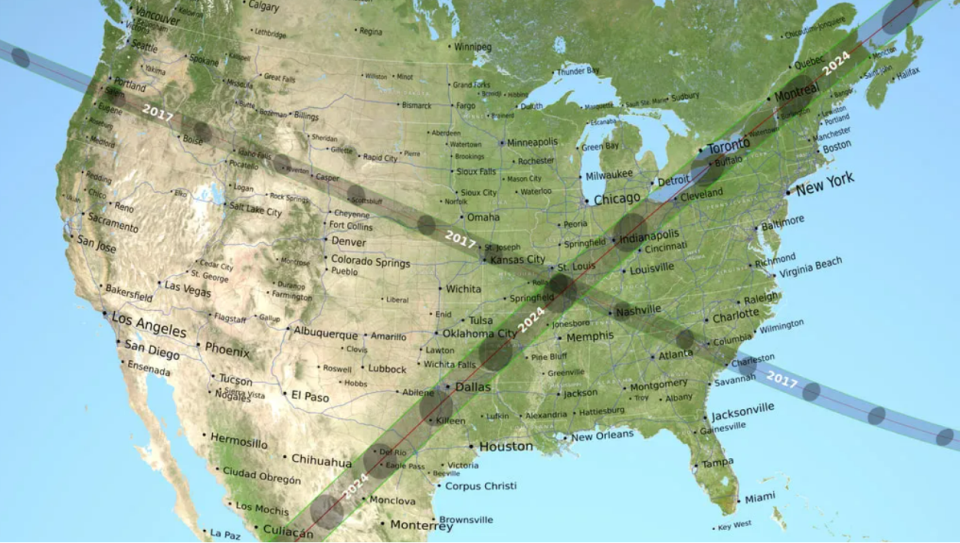Total solar eclipse 2024: What you need to know to prepare for the big event in Colorado
The countdown for the total solar eclipse has begun, but don't worry — you have plenty of time to prepare.
Here is what to know for the big event:
When is the total solar eclipse?
On April 8, the moon’s shadow will sweep across the U.S.
NASA estimates 31.6 million people live in the path of totality compared to 12 million during the total solar eclipse in 2017. An additional 150 million people live within 200 miles of the path of totality and 99% of people who live in the U.S. will see the partial or total eclipse from where they live.
Where is the path of totality with this year's total solar eclipse?
The path of totality, where the moon totally blocks the sun, first enters the U.S. in Texas, then passes through Oklahoma, Arkansas, Missouri, Illinois, Kentucky, Indiana, Ohio, Pennsylvania, New York, Vermont, New Hampshire and Maine, according to NASA.
During any total solar eclipse, totality lasts the longest near the center of the path widthwise and decreases toward the edge. But for the 2024 eclipse, you don't have to be exactly at the center because the time in totality falls off pretty slowly until you get close to the edge, according to NASA.
Visit this interactive map for eclipse times around the country.
What will you see during the 2024 total solar eclipse in Colorado?
Colorado will only see a partial solar eclipse starting around 11:30 a.m. with max partial eclipse at 12:41 p.m. in Fort Collins and the eclipse ending around 1:30 p.m.

How does the 2024 total solar eclipse compare to the last one in 2017?
The path of totality revealing the sun's outer atmosphere, called the corona, will be much wider this year compared to 2017, according to NASA.
During the 2017 total solar eclipse, the moon was a little farther away from Earth than it will be during the upcoming total solar eclipse, causing the path of that eclipse to be a little skinnier.
For comparison, in 2017, the path ranged from 62 to 71 miles wide. During this year's eclipse, the path over North America will range between 108 and 122 miles wide.
The 2024 eclipse path will also pass over more cities and densely populated areas than the 2017 path did.
This year's eclipse will have a longer totality in the U.S., lasting about 4 minutes, 26 seconds at its peak in Texas. In 2017, the longest period of totality was 2 minutes, 42 seconds.
During the 2024 eclipse, the sun will be in or near solar maximum, which will likely create streamers visible throughout the corona and provide a better chance of seeing prominences, which appear as bright pink curls or loops coming off of the sun, according to NASA.
From the archives: Eclipse 2017: 'I need like two more hours of that'
Wait, didn't we just have a solar eclipse in 2023?
On Oct. 14, 2023, the U.S. saw an annular solar eclipse. That happens when the moon passes between the sun and Earth while it is at its farthest point from Earth. Because the moon is farther away from Earth, it appears smaller than the sun and does not completely cover it, instead creating what looks like a ring of fire around the moon.
Do you still need to wear safety glasses if you are not in the path of totality?
NASA says when watching partial phases of the solar eclipse directly with your eyes, which happens before and after totality, you must look through safe eclipse glasses or a safe handheld solar viewer at all times. You can also use an indirect viewing method, such as a pinhole projector.
It's only safe to view the eclipse directly without proper eye protection when the moon completely obscures the sun’s bright face. As soon as you see even a little bit of the bright sun reappear after totality, immediately protect your eyes.
Where can I find eclipse glasses in 2024?
Eclipse glasses have their safety certified by the International Organizations for Standardization. You can tell if a pair of solar eclipse glasses meets today’s standards if they are labeled ISO 12312-2, sometimes written as ISO 12312-2:2015.
You can find a list of certified solar viewer and filter suppliers at https://eclipse.aas.org/eye-safety/viewers-filters.
This article originally appeared on Fort Collins Coloradoan: 2024 solar eclipse guide: Best places to watch in Colorado

